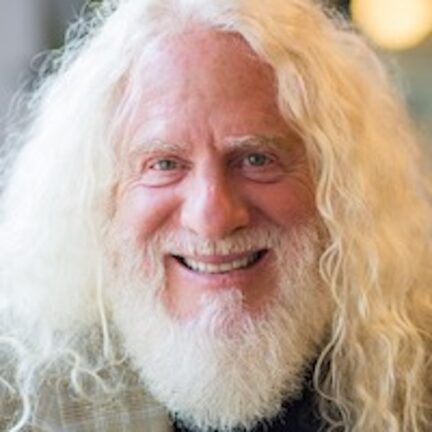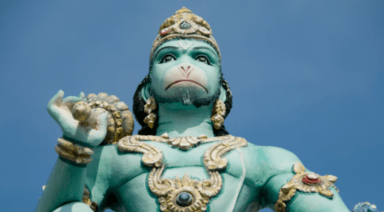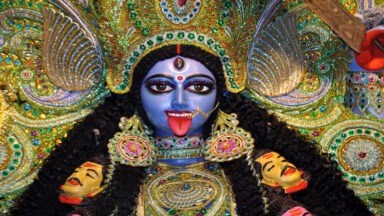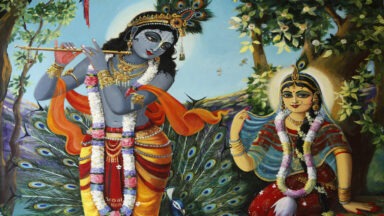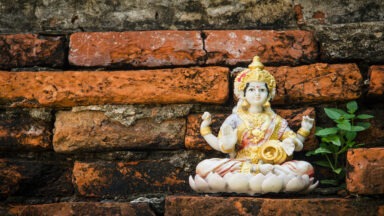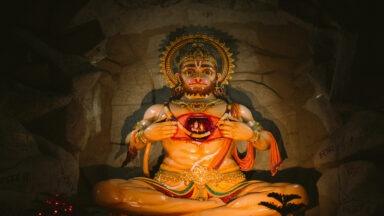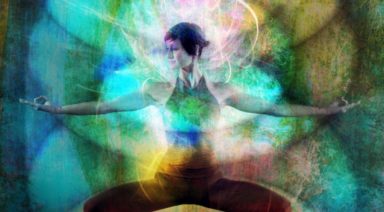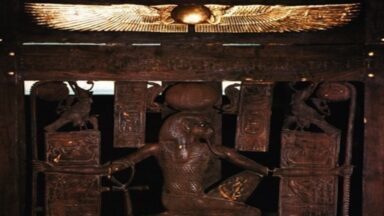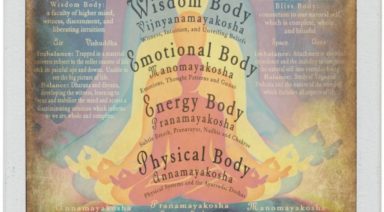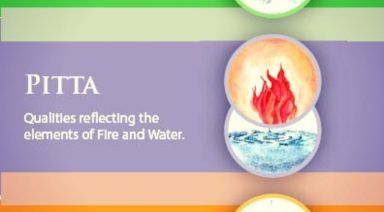What’s in a Mantra?
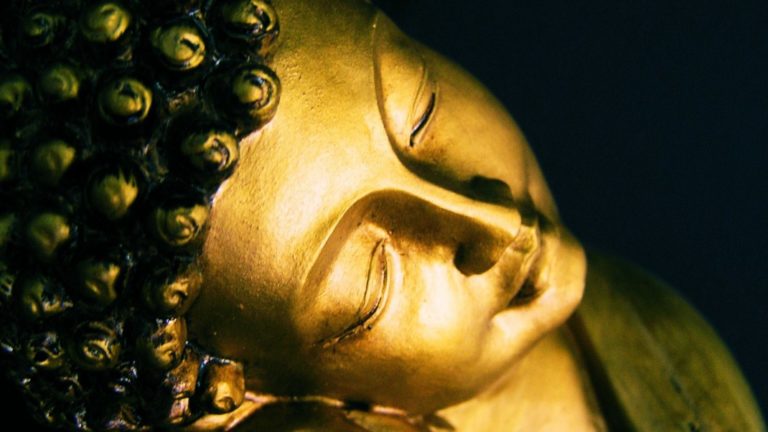
Most yogis know that chanting Om is chanting a mantra and that the word mantra comes from two Sanskrit words: man meaning mind; and tra meaning vehicle or instrument – a tool to transport the mind from a state of activity to one of stillness and silence. We get the words train, travel, and transportation from the Sanskrit root tra. But Om is not simply a word – it’s a seed sound known as a bija – heralding all of the unbounded universe in its very utterance. So let’s dive into the deep end of the mantra pool!
Most mantras are comprised of the fifty letters of the Sanskrit alphabet and can consist of a single letter, a syllable or string of syllables, a word, or a whole sentence. Typically, most mantras are sounds, syllables, or vibrations that don’t necessarily have a meaning. Their value lies in their vibrational quality, not in any meaning that humans, society, culture, or civilization has placed on them over the last few thousand years. For this reason they go beyond the state of human existence on this planet, and they take you deeper because they are vibrations that have existed since the dawn of creation.
The Hymn of the Universe
Om – often referred to as the hymn of the universe – is considered the ultimate vibration because it contains every vibration that has ever existed and every vibration that will ever exist. It’s pure yoga – union. Just as white light contains all the colors of the spectrum, Om contains every sound in the vibrational spectrum – even those we can’t hear with our ears. The cover of Pink Floyd’s Dark Side of the Moon represents this brilliantly as it shows the white light coming into a prism and all the colors of the spectrum coming out the other side. The same could be said for Om – it’s the white light of sound.
Historically, Om is first mentioned in the twelve verses of the ancient Vedic text the Mandukya Upanishads, which explains the three basic states of consciousness: waking, sleeping, and dreaming. In its original spelling and pronunciation, AUM (pronounced ahh-uhh-mmm) is a blending of those three states of consciousness into the one-ness of three distinct syllables: A, U, and M. These three vibrations also represent the three stages of life: birth, living, and death.
The vibration A (pronounced ahh, like the sound you make opening your mouth for the doctor) represents the waking state and the beginning of all things. The letter A is the first letter of most every alphabet, the first letter of the Rig Veda, the Koran, Homer’s Odyssey – even the New Testament! The vibration A heralds creation…the beginning. Vedic sages refer to it as the a-kara and it represents the realm of form and shape – the physical realm.
The vibration U (pronounced oo) is referred to as the u-kara and represents the dream state, the realm that is devoid of form or shape – the realms of air, water, fire, dreams – ever-changing aspects of the formless world around us.
The vibration M is known as the ma-kara, which represents the state of deep sleep – neither form or formless like the other two realms but beyond shape or shapelessness – the realm of consciousness in hibernation, waiting to unfold.
In Sanskrit grammar, when the letters A and U are combined in writing, they are translated as the letter O. That is why we so often see Om written instead of Aum. Over thousands of years, the writing of Aum has taken a back seat to Om, and that has led to Om being the sound that is most often chanted by both Western students and teachers of yoga, meditation, and Vedanta.
When the three individual vibrations are combined, a fourth vibration is created like a chord in music made up of individual notes. AUM (pronounced ahhh–uhhh–mmmm) represents the fourth state of consciousness – transcendent consciousness or turiya – what we call enlightenment or one-ness. In Vedanta, it’s the unity of the divine made up of its three components: creation; preservation; destruction (and rebirth). The chanting of this mantra heralds our universality, which is why we usually chant Om before and/or after meditation and yoga practice, and when we read sacred, ancient texts. By repeating a vibration or sound over and over, it will become part of your physiology; it will become your mind; it will become *you. * It will lose all meaning, all definition, and all relevance. There will be no separation between you and the vibration that is resonating right now.
Chanting Om (out loud or silently) is an ideal reminder of our universality.
Hanuman: Myth, Mantra and Asana

Hanuman was born on the wind and a prayer. His father was Kesari, a sort of meditating gladiator monkey-like humanoid, called in Sanskrit, a “vanara”. His mother, Anjana, held the essence of her name: “anj” in Sanskrit means reverence.
Anjana and Kesari really wanted a kid and prayed to Lord Shiva for the blessing of conceiving a son. Shiva, pleased by their devotion and prayers, sent Vayu, the god of wind, to carry Shiva’s essence to fulfill their wishes, perhaps something like a sacred stork.
Turns out that Vayu delivered a pretty gifted kid. Like his gladiator father and like many of our modern-day mixed martial art competitors, Hanuman had a plethora of skills and talents. He wrestled demons, transformed himself to fit the needs of the particular circumstances against which he was fighting, and did so all with unwavering devotion.
Hanuman was devoted to Lord Rama, the god of righteousness and virtue.
Through his devotion, he was characterized as a lifelong Brahmachari (celibate). The belief that Hanuman’s celibacy is the source of his strength became popular among the wrestlers in India.
Hanuman: Behind the Name
Sanskrit texts mention several stories about how Hanuman got his name. Hanuman had a lifelong obsession with the sun, and as a youngster, blazed towards it, mistaking the sun for a mango and mischievously chomping a bite out of it. This really pissed off Indra, the king of the gods, who struck Hanuman’s jaw with lightening, to scold his impetuous nature. A bit harsh, right? Regardless, Hanuman is said to have received his name from the Sanskrit words “hanu” meaning jaw, and “man” meaning prominent or disfigured.
Another lore credits the name as a derivative of the Sanskrit words “han” meaning killed or destroyed, and “mana” meaning pride; indicating that Hanuman is the one whose pride was destroyed.
As Saul David Raye shares in Earth Heart Hanuman, “humility comes when the jaw is broken.” Whether you’re an elite mixed martial artist, or simply a modern-day yogi maneuvering through daily challenges, we discover that when our hearts are full of devotion, our spirit is unbreakable. Saul David Raye says that the stories of Hanuman can teach us, “the balance of incredible opening while still staying balanced.”
It’s Hanuman we can thank for the devotion it takes to practice Sun Salutations, or Surya Namaskars, which are a series of poses linked by the breath. Sun Salutations invite us to bow to and unite with the sun, as a pathway to the divine.

